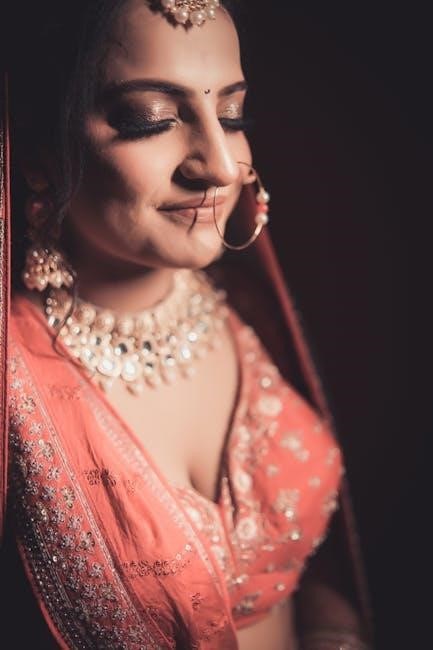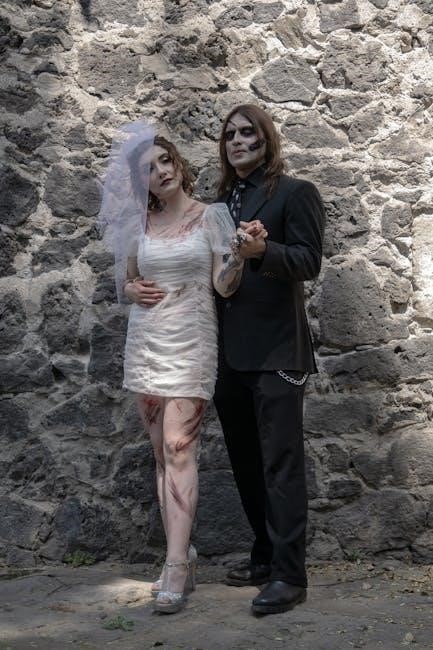the fake poor bride pdf
The Fake Poor Bride PDF explores the deceptive practices of wealthy brides feigning poverty to exploit societal sympathy, revealing shocking truths about luxury weddings and societal expectations.
Overview of the Article
The Fake Poor Bride PDF delves into the intriguing phenomenon of wealthy individuals feigning poverty to manipulate societal perceptions, particularly in the context of luxury weddings. It highlights how some brides exploit the notion of financial hardship to gain sympathy and attention, often with the help of wedding planners. The article exposes the elaborate deceptions, including staged backstories and exaggerated displays of wealth, revealing the darker side of societal expectations surrounding marriage. By examining real-life case studies, the PDF sheds light on the psychological and sociological factors driving this trend, offering a critical perspective on the intersection of deception, marriage, and social status.

Importance of the Topic in Modern Society
The phenomenon of the fake poor bride highlights critical issues in modern society, such as economic disparity, societal pressure, and the commodification of marriage. By examining this trend, the PDF reveals how luxury weddings have become stages for displaying wealth, often at the expense of authenticity. The manipulation of poverty narratives underscores the lengths individuals go to meet societal expectations, raising questions about honesty and integrity in relationships. This topic also sheds light on the role of deception in maintaining social status, making it a relevant subject for discussions on class, morality, and the evolving dynamics of marriage in contemporary culture.

The Origins of the “Fake Poor Bride” Phenomenon
The fake poor bride phenomenon emerged from organized marriage gangs, where individuals like Anuradha deceived families by portraying themselves as impoverished brides to exploit financial resources.
The Story Behind the “Fake Poor Bride” Concept
The concept of the fake poor bride gained prominence through Xochitl Gonzalez’s article in The Atlantic, detailing her experiences as a luxury wedding planner. She revealed how wealthy brides feigned financial struggles to gain sympathy and manipulate situations, often with the help of planners who staged elaborate deceptions. This phenomenon highlights the lengths to which some individuals go to maintain social appearances, blending deception with luxury. Gonzalez’s insights into this trend expose the darker side of societal expectations and the wedding industry’s role in enabling such charades, making it a fascinating yet troubling narrative.
Historical Context of Marriage and Deception
Marriage has long been intertwined with deception, particularly for financial gain. Historically, women from poorer backgrounds were often coerced into marriages for economic stability, while others feigned poverty to attract wealthier suitors. The concept of deception in marriage dates back to arranged unions, where social status and wealth were paramount. In modern times, the fake poor bride phenomenon reflects a twisted evolution of this tradition, where luxury and deceit coexist. This tactic, as seen in cases like Anuradha’s fake marriage gang, highlights how societal pressures and economic disparities continue to drive such practices, blending ancient strategies with contemporary societal expectations.
The Psychology of the “Fake Poor Bride”
The fake poor bride phenomenon reveals a complex interplay of manipulation, hidden agendas, and societal pressures, driven by psychological motives to exploit emotions for financial or social gain.
Motivations Behind the Deception
The fake poor bride phenomenon is driven by financial gain, social manipulation, and the desire to exploit emotions. These individuals often feign poverty to gain sympathy and financial support, leveraging societal expectations of wedding expenses. The deception is carefully orchestrated, with some brides even hiring fake families or creating fabricated backstories to appear destitute. This manipulation allows them to extract resources from wealthy grooms or their families, often under the guise of needing assistance for the wedding. The psychological tactics involved reveal a calculated effort to exploit trust and generosity, highlighting the darker side of marriage economics and societal pressures surrounding weddings.
The Role of Social Pressure and Expectations
Social pressure and societal expectations play a significant role in the “fake poor bride” phenomenon. Many brides feel compelled to present a certain image due to cultural or familial demands, leading them to fake poverty to gain sympathy or financial support. The pressure to host grand weddings, often driven by societal norms, pushes some individuals to deceive others about their financial status. This deception is further fueled by the desire to meet unrealistic expectations of wedding luxury, creating a cycle of fraud and emotional manipulation. The influence of wedding planners, who sometimes encourage elaborate displays of wealth, also perpetuates this trend, highlighting how societal pressures shape deceptive behaviors in marriage and wedding culture.

The Sociology of Fake Poverty in Marriage
The phenomenon of fake poverty in marriage reflects societal pressures and economic disparities, where individuals deceive to exploit financial support, often fueled by organized gangs and cultural expectations.
Social Stratification and Economic Disparities

Social stratification and economic disparities play a significant role in the “Fake Poor Bride” phenomenon. Wealthy individuals often feign poverty to exploit societal sympathy and financial support, particularly in contexts where economic inequality is rampant. This deception is perpetuated by organized gangs, who target vulnerable individuals and manipulate cultural expectations of marriage. The phenomenon highlights the deep-rooted issues of class division and economic exploitation, where the wealthy prey on the trust of others to maintain their status. Such practices not only undermine social trust but also perpetuate cycles of inequality, making it difficult for genuinely impoverished individuals to access legitimate support.
Case Studies of Fake Marriage Gangs
Case studies reveal organized gangs exploiting the “Fake Poor Bride” ruse, targeting vulnerable individuals for financial gain. These groups often operate across borders, luring victims with promises of marriage and financial stability. Anuradha, a gang leader, exemplified this by orchestrating fake marriages to cheat people of money. Such gangs thrive in regions with economic disparities, where desperation meets deception. Their methods involve elaborate schemes, including staged weddings and fabricated stories of poverty, to extract resources from unsuspecting individuals. These case studies expose the intricate networks and manipulative tactics used to perpetuate this form of fraud, highlighting the need for stricter legal measures to combat such exploitation.
The Wedding Industry’s Role in the Phenomenon
The wedding industry’s emphasis on luxury and societal expectations fuels the “Fake Poor Bride” trend, as high-end planners and extravagant budgets create an environment where deception thrives.

Luxury Weddings and the Display of Wealth
Luxury weddings have become a platform for showcasing wealth, with seven-figure budgets and extravagant displays. The “Fake Poor Bride” phenomenon thrives in this environment, as high-end wedding planners cater to the elite, creating illusions of opulence. These events often feature excessive spending, from gourmet catering to elaborate decorations, reinforcing societal expectations of grandeur. The fake poor bride exploits this by presenting a modest facade while secretly enjoying the luxury. This trend highlights how the pursuit of status and validation drives deception, even in the most intimate celebrations. The wedding industry’s emphasis on excess inadvertently fuels such behaviors, blurring the lines between authenticity and spectacle. Wealth display becomes a tool for manipulation, enabling fake poor brides to exploit sympathy while maintaining a luxurious lifestyle.
The Impact of Wedding Planners on the Trend
Wedding planners play a pivotal role in perpetuating the “Fake Poor Bride” trend. They often facilitate elaborate deceptions, creating illusions of modesty while orchestrating luxurious events. Planners may even stage fake firings or pretend to manage tight budgets to uphold the ruse. Their expertise in blending opulence with deceit allows brides to maintain their facade while indulging in extravagance. This collaboration between planners and brides highlights how professional services enable and normalize such manipulative behaviors. The planners’ involvement not only sustains the trend but also escalates its complexity, making it harder to distinguish between genuine and fabricated narratives in high-society weddings. Their role underscores the intersection of deception and professionalism in the wedding industry.

The “Fake Poor Bride PDF” and Its Popularity
The Fake Poor Bride PDF has gained significant attention for its shocking insights into luxury weddings and societal deception, resonating widely due to its bold and revealing narrative style.

Key Themes and Insights from the PDF

The Fake Poor Bride PDF delves into themes of deception, luxury, and societal expectations. It reveals how wealthy individuals manipulate perceptions of poverty to gain sympathy and financial advantages. The document exposes the tactics used by fake brides, including fabricated stories of hardship and strategic emotional manipulation. It also highlights the role of wedding planners in facilitating these deceptions, often for financial gain. The PDF further explores the psychological motivations behind such actions, shedding light on the intersection of greed, societal pressure, and the lengths people go to maintain illusions of poverty. These insights provide a startling look into the darker side of marriage and deception in modern society.
Why the PDF Has Garnered Significant Attention
The Fake Poor Bride PDF has gained widespread attention due to its shocking revelations about luxury weddings and deception. It offers a unique glimpse into the manipulation of societal expectations, where wealthy individuals feign poverty for personal gain. The document’s exposure of fake marriage gangs and the involvement of wedding planners has sparked public outrage and curiosity. Its relatability to modern societal issues, such as economic disparities and the pressure to conform, has further amplified its popularity. The PDF’s controversial themes and real-life anecdotes have made it a topic of discussion, attracting readers eager to understand the darker side of marriage and deception in contemporary culture.
The Fake Poor Bride PDF underscores societal reflections on deception and economic disparities, prompting discussions on trust in marriage and the need for systemic change to address such trends.

The Long-Term Effects of the “Fake Poor Bride” Trend
The Fake Poor Bride trend has far-reaching implications, eroding trust in marital relationships and perpetuating economic disparities. Society may become more cynical about true intentions in marriage, leading to increased scrutiny of brides’ backgrounds. This deception could also normalize manipulation, blurring ethical boundaries in personal and financial matters. Over time, such practices may reinforce harmful stereotypes about poverty and marriage, making it harder for genuinely disadvantaged individuals to gain support. Additionally, legal consequences for those involved in such schemes could lead to stricter marriage regulations, potentially stifling genuine relationships. The trend underscores the need for societal reflection on honesty, equality, and the true meaning of marriage.
Lessons Learned and Societal Reflections
The Fake Poor Bride phenomenon prompts society to reflect on the ethical implications of deception in relationships. It highlights how financial disparities and societal expectations can lead individuals to manipulate others for personal gain. This trend serves as a cautionary tale about the dangers of superficiality and the exploitation of trust. Societal reflections reveal a need for greater empathy and understanding, urging individuals to look beyond appearances and question the motivations behind such schemes. Ultimately, the phenomenon underscores the importance of authenticity in relationships and the need for systemic changes to address economic inequalities that drive such deceptive behaviors, fostering a more equitable and honest society.
